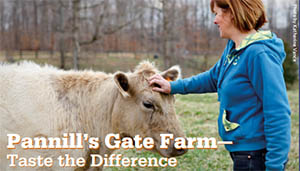“Come ‘ere babies, who’s gonna come visit?” Patty Johnson calls out as we climb the fence into the field at Pannill’s Gate farm near Culpeper, Virginia. The cows regard her carefully, presumably weighing their chances of getting food or a scratch on the head. Every day, Patty is out in the fields, checking on her entirely grass-fed herd of Red Angus and Murray Grey cattle. For her, the practice of rotational grazing, or moving the cows to a new strip of pasture daily, “re-establishes that relationship- why I am here and why I do this.”

Patty and her husband Scott started the herd in 1995 as a conventional cow-calf operation. A few years later, hoping to reduce feed costs, they discovered “stockpiling”- leaving the grass on the ground through the winter rather than baling it as hay. From there, it was an obvious transition to a year-round, grass-fed operation, and Patty says they haven’t looked back since. In addition, rotational grazing is a healthy land management strategy that reduces over-trampling and soil erosion.
The meat that the cows produce today is the best proof that the Johnsons are raising their cows well. “Its really, really noticeable,” she says. “I can taste it in the beef- the complexity of the flavor and the boldness. If I eat store-bought beef, my first impression is that it tastes flat.”
If the resident bull, affectionately known as “Chunky”, could hear this praise of his herd, perhaps he would be proud. But he just continues his benign rule in peace. With the onset of Spring, his concern is with the young, green shoots of newly sprouted grass.
